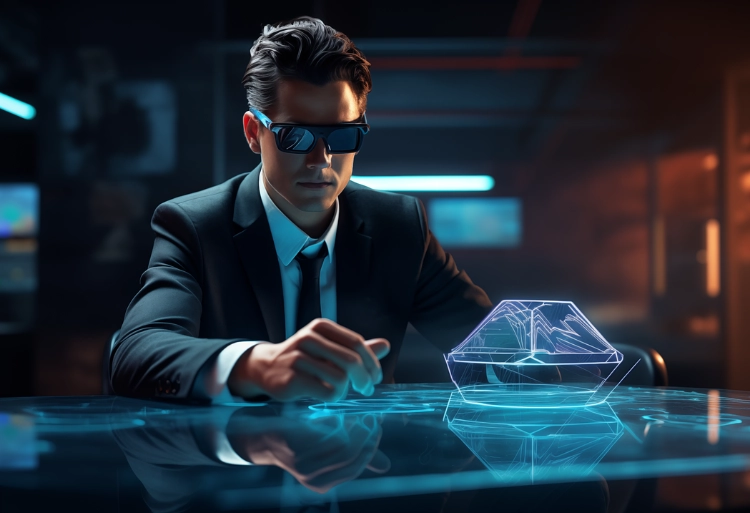In the realm of extended reality (XR), the terms virtual reality (VR), augmented reality (AR), and mixed reality (MR) represent distinct yet interconnected technologies. VR immerses users in a fully immersive digital environment through a VR headset, allowing them to explore computer-generated worlds. This creates an engaging VR experience that is often used for gaming and VR training simulations. In contrast, AR technology overlays digital elements onto the real-world environment, enhancing experiences without removing the physical context. Popular applications like Pokemon Go exemplify this by blending digital entities with real locations. Finally, mixed reality (MR) merges both augmented reality and virtual reality, allowing interaction between the real and virtual. Devices like the wearable display enable users to engage with both virtual elements and their physical surroundings, showcasing the difference between augmented reality and mixed reality.
The difference between augmented reality and mixed reality lies in their levels of interaction and immersion. While AR enhances reality by adding computer-generated images to the real world, MR allows for a more complex interaction where actual and digital objects coexist and interact in real-time. This makes MR experiences more dynamic and immersive compared to basic AR experiences. For instance, a MR headset can facilitate complex simulations that respond to user actions, offering a rich blend of the physical and virtual realms. As technology continues to evolve, understanding the nuances of VR vs AR and MR will be crucial for harnessing their potential in various use cases, from entertainment to professional training.

What is Virtual Reality (VR)?
Virtual Reality (VR) is an immersive technology that creates a simulated environment, allowing users to interact with virtual objects through a VR headset. Unlike augmented reality (AR), which overlays digital elements onto the real world, VR transports users entirely into a virtual world. This fully immersive experience is a part of the broader extended reality (XR) umbrella term that encompasses AR, VR, and mixed reality (MR). While AR tech enhances the real-world environment, VR focuses on creating a new virtual environment where users can engage in various activities, from entertainment to simulated training. The difference between AR and VR lies in the level of immersion; VR offers a complete escape from reality, while AR merges the actual and digital.
In the realm of technology, the wearable display exemplifies an AR headset, allowing users to experience augmented reality and mixed reality by integrating virtual elements with their physical surroundings. On the other hand, a VR experience is facilitated by a virtual reality headset, which immerses users in a computer-generated simulation. Popular applications like Pokemon Go showcase the engaging potential of AR, while VR vs AR often highlights unique use cases for each technology. The MR experience further blurs the lines, creating interactive scenarios where real and virtual worlds coexist. Understanding these distinctions is crucial for harnessing the full power of VR and AR technologies.
What is Augmented Reality (AR)?
Augmented Reality (AR) is a technology that alters reality by overlaying computer-generated digital elements onto the tangible environment. Unlike Virtual Reality (VR), which immerses users in a entirely immersive digital environment through a VR headset, AR enhances the physical space around the user. This immersive AR experience allows users to interact with virtual objects in real-time, bridging the gap between the actual and digital worlds.
Within the broader scope of Extended Reality (XR), which encompasses both AR and VR, the difference between AR and Mixed Reality (MR) lies in how these technologies blend the physical and virtual realms. A MR headset provides users with an experience that interacts seamlessly with real-world elements, while AR primarily overlays virtual elements onto the existing environment. The Hololens is a notable device that exemplifies the capabilities of augmented reality and mixed reality , showcasing the potential of VR and AR in various use cases like VR training and interactive simulations.
What is Mixed Reality (MR)?
Mixed Reality (MR) is an umbrella term that encompasses both augmented reality (AR) and virtual reality (VR), creating a blend of the real and virtual worlds. It allows users to interact with machine-generated environments and digital entities while still being aware of their real-world surroundings. Through the use of a MR headset, users can experience a fully immersive digital reality that integrates digital elements seamlessly into their physical environment.
The difference between AR and MR lies in the level of immersion and interaction; while AR simply adds virtual elements to the real world, MR creates an interactive virtual environment where users can manipulate both physical and virtual objects. Tools like the HoloLens exemplify this technology that alters reality, allowing for various use cases such as VR training and gaming. As the lines between virtual and augmented reality blur, MR is poised to redefine how we interact with the world around us.
How to Create Design Plans for Virtual and Augmented Reality Experiences
Creating design plans for virtual and augmented reality experiences involves understanding the nuances between AR, VR, and XR, the umbrella term that encompasses all immersive technologies. A key aspect is defining the VR experience within a virtual world using VR headsets that transport users into a entirely immersive environment. Additionally, consider how hybrid reality integrate real-world elements with machine-generated content.
When designing for AR and VR, it's crucial to understand the contrast between AR and VR vs MR ( mixed reality ). AR tech adds digital entities to real spaces, while VR engage users in a completely separate virtual environment. Use cases may include simulated training simulations where users can safely practice scenarios, or MR experiences that blend actual and digital elements for enhanced learning. Employing devices like the Hololens or various reality headsets can significantly enhance user immersion and interaction.
Conclusion on Extended Reality
In conclusion, if you're ready to dive into the world of VR and AR, Studio Liddell stands out as the best development company to help you get started. Their expertise in extended reality (XR) solutions ensures that you can create immersive experiences tailored to your needs. Whether you're utilizing a VR headset for a full digital reality or exploring AR technology with a Hololens, they provide the tools to blend computer-generated elements with real-world environments, allowing users to immerse themselves in both virtual and augmented realities.
Studio Liddell understands the difference between AR and VR, as well as the nuances of mixed reality (MR) applications. They can help you navigate the VR vs AR landscape, ensuring you maximize the potential of your reality headset or AR headset. From entertainment experiences like Pokemon Go to advanced VR training simulations, their team can elevate your projects. By leveraging digital elements within both virtual environments and real and virtual spaces, they create unique AR experiences that captivate audiences.
Whether your focus is on digital entities or physical and virtual integration, Studio Liddell is equipped to guide you through the complexities of hybrid reality. They highlight the use cases that matter most to your business, illustrating how VR and AR can transform your vision into reality. With an understanding of the difference between augmented reality and mixed reality , they ensure your projects are not just innovative but also fully immersive and engaging.
Looking for a Virtual Reality (VR) Development company, we can help.
Call now +44 (0) 7798 834 159

